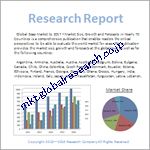目次
第1章.自律型建設機械の世界市場 エグゼクティブサマリー
1.1.自律型建設機械の世界市場規模・予測(2022年~2032年)
1.2.地域別概要
1.3.セグメント別概要
1.3.1.機器別
1.3.2.自動化レベル別
1.3.3.推進力別
1.3.4.用途別
1.3.5.出力別
1.4.主要トレンド
1.5.景気後退の影響
1.6.アナリストの提言と結論
第2章 自律型建設機械の世界市場世界の自律型建設機械市場の定義と調査前提
2.1.調査目的
2.2.市場の定義
2.3.調査の前提
2.3.1.包含と除外
2.3.2.限界
2.3.3.供給サイドの分析
2.3.3.1.入手可能性
2.3.3.2.インフラ
2.3.3.3.規制環境
2.3.3.4.市場競争
2.3.3.5.経済性(消費者の視点)
2.3.4.需要サイド分析
2.3.4.1.規制の枠組み
2.3.4.2.技術の進歩
2.3.4.3.環境への配慮
2.3.4.4.消費者の意識と受容
2.4.推定方法
2.5.調査対象年
2.6.通貨換算レート
第3章.自律型建設機械の世界市場ダイナミクス
3.1.市場促進要因
3.1.1.電動技術と自律型技術の採用の増加
3.1.2.センサーとAI技術の進歩
3.1.3.持続可能な建設に対する政府のインセンティブ
3.2.市場の課題
3.2.1.初期投資コストの高さ
3.2.2.統合における技術的な複雑さ
3.3.市場機会
3.3.1.スマート建設プロジェクトの拡大
3.3.2.戦略的コラボレーションとパートナーシップ
3.3.3.自律型設備設計の革新
第4章.世界の自律型建設機械市場の産業分析
4.1.ポーターの5フォースモデル
4.1.1.サプライヤーの交渉力
4.1.2.バイヤーの交渉力
4.1.3.新規参入者の脅威
4.1.4.代替品の脅威
4.1.5.競合他社との競争
4.1.6.ポーターの5フォースモデルへの未来的アプローチ
4.1.7.ポーター5フォースのインパクト分析
4.2.PESTEL分析
4.2.1.政治的
4.2.2.経済的
4.2.3.社会的
4.2.4.技術的
4.2.5.環境
4.2.6.法律
4.3.主な投資機会
4.4.トップ勝ち組戦略
4.5.破壊的トレンド
4.6.業界専門家の視点
4.7.アナリストの推奨と結論
第5章 自律型建設機械の世界市場自律型建設機械の世界市場規模・予測:機器別2022年~2032年
5.1.セグメントダッシュボード
5.2.自律型建設機械の世界市場機器収益動向分析、2022年・2032年 (百万米ドル/億ドル)
5.2.1.ドーザー
5.2.2.ダンプトラック
5.2.3.ローダー
5.2.4.掘削機
5.2.5.運搬トラック
5.2.6.コンパクター
第6章.自律型建設機械の世界市場規模・自動化レベル別予測 2022-2032
6.1.セグメントダッシュボード
6.2.自律型建設機械の世界市場自動化レベル別売上動向分析、2022年・2032年 (百万米ドル/億ドル)
6.2.1.半自律型
6.2.2.完全自律型
第7章 自律型建設機械の世界市場自律型建設機械の世界市場規模・地域別予測 2022-2032
7.1.北米の自律型建設機械市場
7.1.1.米国の自律型建設機械市場
7.1.1.1.機器の内訳規模・予測、2022年~2032年
7.1.1.2.自動化レベル内訳規模・予測、2022年~2032年
7.1.2.カナダの自律型建設機械市場
7.2.欧州の自律型建設機械市場
7.2.1.イギリスの自律型建設機械市場
7.2.2.ドイツの自律型建設機械市場
7.2.3.フランスの自律型建設機械市場
7.2.4.スペインの自律型建設機械市場
7.2.5.イタリアの自律型建設機械市場
7.2.6.その他のヨーロッパの自律型建設機械市場
7.3.アジア太平洋地域の自律型建設機械市場
7.3.1.中国の自律型建設機械市場
7.3.2.インドの自律型建設機械市場
7.3.3.日本の自律型建設機械市場
7.3.4.オーストラリアの自律型建設機械市場
7.3.5.韓国の自律型建設機械市場
7.3.6.その他のアジア太平洋地域の自律型建設機械市場
7.4.中南米の自律型建設機械市場
7.4.1.ブラジルの自律型建設機械市場
7.4.2.メキシコの自律型建設機械市場
7.4.3.その他のラテンアメリカの自律型建設機械市場
7.5.中東・アフリカの自律型建設機械市場
7.5.1.サウジアラビアの自律型建設機械市場
7.5.2.南アフリカの自律型建設機械市場
7.5.3.その他の中東・アフリカの自律型建設機械市場
第8章 自律型建設機械市場競合他社の動向
8.1.主要企業のSWOT分析
8.1.1.キャタピラー社
8.1.2.コマツ
8.1.3.日立建機
8.2.トップ市場戦略
8.3.企業プロフィール
8.3.1.キャタピラー
8.3.1.1.主要情報
8.3.1.2.概要
8.3.1.3.財務(データの入手可能性による)
8.3.1.4.製品概要
8.3.1.5.市場戦略
8.3.2.コマツ
8.3.3.日立建機
8.3.4.ボルボ建機
8.3.5.Liebherr グループ
8.3.6.ディア・アンド・カンパニー
8.3.7.CNH Industrial N.V.
8.3.8.現代建設機械
8.3.9.Doosan Corporation
8.3.10.XCMG グループ
8.3.11.SANY グループ
8.3.12.テレックス・コーポレーション
8.3.13.株式会社ジェーシービー
8.3.14.コベルコ建機株式会社
8.3.15.ズームライオン重工業科学技術株式会社
第9章.研究プロセス
9.1.研究プロセス
9.1.1.データマイニング
9.1.2.分析
9.1.3.市場推定
9.1.4.バリデーション
9.1.5.出版
9.2.研究属性
表一覧
表1.自律型建設機械の世界市場、レポートスコープ
表2.自律型建設機械の世界市場地域別推計・予測 2022-2032 (百万米ドル/億ドル)
表3.自律型建設機械の世界市場:機器別2022年〜2032年予測・予測 (百万ドル/億ドル)
表4.自律型建設機械の世界市場:自動化レベル別推計・予測 2022-2032 (百万ドル/億米ドル)
表5.自律型建設機械の世界市場:2022-2032年(百万ドル/億米ドル)機器別推定・予測
表6.自律型建設機械の世界市場:自動化レベル別推計・予測 2022-2032年 (百万米ドル/億米ドル)
表7.自律型建設機械の世界市場:2022-2032年(百万米ドル/億米ドル)機器別見積もり・予測
表8.自律型建設機械の世界市場:自動化レベル別2022年〜2032年予測・予測(USD Million/Billion)
表9.自律型建設機械の世界市場:2022-2032年(百万ドル/億米ドル)機器別推定・予測
表10.自律型建設機械の世界市場:自動化レベル別見積もりと予測 2022-2032 (百万米ドル/億米ドル)
表11.自律型建設機械の世界市場:2022-2032年(百万ドル/億米ドル)機器別見積もり・予測
表12.自律型建設機械の世界市場:自動化レベル別見積もりと予測 2022-2032 (百万米ドル/億米ドル)
表13.自律型建設機械の世界市場:2022-2032年(百万米ドル/億米ドル)機器別推定・予測
表14.自律型建設機械の世界市場:自動化レベル別見積もりと予測 2022-2032 (百万米ドル/億米ドル)
表15.米国の自律型建設機械市場の見積もりと予測:2022〜2032年(USD Million/Billion)
表16.米国の自律型建設機械市場の機器別見積もりと予測、2022~2032年 (百万米ドル/億ドル)
表17.米国の自律型建設機械市場の自動化レベル別推計と予測 2022-2032 (百万米ドル/億ドル)
表18.カナダの自律型建設機械市場の見積もりと予測:2022〜2032年(百万米ドル/億ドル)
表19.カナダの自律型建設機械市場の機器別見積もりと予測、2022~2032年 (百万米ドル/億ドル)
表20.カナダの自律型建設機械市場の自動化レベル別推計と予測 2022-2032 (百万米ドル/億ドル)
…
最終報告書には100以上の表が含まれます。このリストは最終成果物で更新される可能性があります。
図表一覧
図1.自律型建設機械の世界市場、調査手法
図2.自律型建設機械の世界市場:市場予測手法
図3.世界の市場規模推計と予測手法
図4.自律型建設機械の世界市場、主要動向2023年
図5:自律型建設機械の世界市場自律型建設機械の世界市場、成長見通し2022年~2032年
図6.自律型建設機械の世界市場、ポーターの5フォースモデル
図7.自律型建設機械の世界市場、PESTEL分析
図8.自律型建設機械の世界市場、バリューチェーン分析
図9.自律型建設機械の世界市場(セグメント別)、2022年・2032年(百万ドル/億ドル
図10.自律型建設機械の世界市場:セグメント別、2022年・2032年(百万ドル/億ドル)
図11.自律型建設機械の世界市場:セグメント別、2022年・2032年(百万ドル/億ドル)
図12.自律型建設機械の世界市場:セグメント別、2022年・2032年(百万ドル/億ドル)
図13.自律型建設機械の世界市場:セグメント別、2022年・2032年(百万ドル/億ドル)
図14.自律型建設機械の世界市場、地域別スナップショット(2022年・2032年
図15.北米の自律型建設機械市場:2022年〜2032年(百万ドル/億ドル)
図16.欧州の自律型建設機械市場 2022 & 2032 (百万米ドル/億米ドル)
図17.アジア太平洋地域の自律型建設機械市場 2022 & 2032 (百万米ドル/億米ドル)
図18.中南米の自律型建設機械市場 2022 & 2032 (百万米ドル/億米ドル)
図 19.中東・アフリカの自律型建設機械市場 2022 & 2032 (百万米ドル/億米ドル)
図 20.自律型建設機械の世界市場、企業市場シェア分析(2023年)
…
このリストは完全なものではなく、最終報告書には50以上の図表が含まれます。リストは最終成果物で更新される可能性があります。
The adoption of autonomous construction equipment is driven by increasing urbanization and the subsequent surge in large-scale infrastructure projects. Governments worldwide are prioritizing smart cities and sustainable infrastructure initiatives, creating a fertile ground for the deployment of semi- and fully autonomous machinery. These systems offer unparalleled precision in excavation, material handling, and other tasks, ensuring optimal resource utilization. Moreover, the transition to electric and hybrid propulsion systems within this domain aligns with the global push toward carbon neutrality, further enhancing market potential.
Despite its promising outlook, the market faces challenges such as high initial investment costs and the complexity of integrating automation into existing equipment fleets. Additionally, concerns regarding cybersecurity and system interoperability could hinder adoption. However, ongoing advancements in sensor technology and predictive maintenance systems are expected to address these barriers. Collaborative efforts between manufacturers and technology providers are also fostering innovation, ensuring that autonomous solutions cater to diverse construction needs.
From a regional perspective, North America dominates the autonomous construction equipment market, driven by its robust infrastructure development projects and early adoption of advanced construction technologies. Europe follows closely, supported by stringent environmental regulations and a strong emphasis on sustainable building practices. Meanwhile, the Asia-Pacific region is anticipated to exhibit the fastest growth, fueled by rapid urbanization and significant investments in infrastructure development in countries like China and India.
Major market players included in this report are:
• Caterpillar Inc.
• Komatsu Ltd.
• Hitachi Construction Machinery Co., Ltd.
• Volvo Construction Equipment
• Liebherr Group
• Deere & Company
• CNH Industrial N.V.
• Hyundai Construction Equipment Co., Ltd.
• Doosan Corporation
• XCMG Group
• SANY Group
• Terex Corporation
• JCB Ltd.
• Kobelco Construction Machinery Co., Ltd.
• Zoomlion Heavy Industry Science and Technology Co., Ltd.
The detailed segments and sub-segment of the market are explained below:
By Equipment:
• Dozers
• Dump Trucks
• Loaders
• Excavators
• Haul Trucks
• Compactors
By Level of Automation:
• Semi-Autonomous
• Fully-Autonomous
By Propulsion:
• Electric
• Hybrid
• Conventional
By Application:
• Earthmoving
• Material Handling
• Road Construction
• Mining
• Others
By Power Output:
• Less than 50 HP
• 50-200 HP
• More than 200 HP
By Region:
North America
• U.S.
• Canada
Europe
• UK
• Germany
• France
• Spain
• Italy
• Rest of Europe
Asia Pacific
• China
• India
• Japan
• Australia
• South Korea
• Rest of Asia Pacific
Latin America
• Brazil
• Mexico
• Rest of Latin America
Middle East & Africa
• Saudi Arabia
• South Africa
• Rest of Middle East & Africa
Years considered for the study are as follows:
• Historical year – 2022
• Base year – 2023
• Forecast period – 2024 to 2032
Key Takeaways:
• Market estimates & forecasts for 10 years from 2022 to 2032.
• Annualized revenues and regional-level analysis for each market segment.
• Detailed analysis of geographical landscape with country-level analysis of major regions.
• Competitive landscape with information on major players in the market.
• Analysis of key business strategies and recommendations for future market approaches.
• Analysis of the competitive structure of the market.
• Demand-side and supply-side analysis of the market.
❖ 免責事項 ❖
http://www.globalresearch.jp/disclaimer

